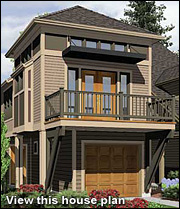Green Home Checklist

Since green building is still a relatively new process, it's a good idea to research green building on your own so you know what to look for when choosing your site, home plan, builder and sustainable products.
Here is a checklist of things to consider when building a green home:
•
Location: New green homes and neighborhoods must not be built on environmentally sensitive sites like prime farmland, wetlands and endangered species habitats. The greenest development sites are "in-fill" properties like former parking lots, rail yards, shopping malls and factories. Be sure to study your property carefully so you can put the sun to work for you and your home. When it comes to clearing your lot, take down only the necessary trees and bushes. The trees you leave behind will act as a shade barrier in the summer months and wind barrier in the colder months.
•
Size: No matter how many green building elements go into your home, a 5,000-square-foot green home still consumes many more natural resources than a 2,000-square-foot green home. The larger home will also require more heating, air conditioning and lighting. If you really want a sustainable home, choose a smaller size.
•
Building Design: The home should be oriented on its site to bring abundant natural daylight into the interior to reduce lighting requirements and to take advantage of any prevailing breezes. Windows, clerestories, skylights, light monitors, light shelves and other strategies should be used to bring daylight to the interior of the house. The exterior should have shading devices (sunshades, canopies, green screens and — best of all — trees), particularly on the southern and western facades and over windows and doors, to block hot summer sun. Dual-glaze windows reduce heat gain in summer and heat loss during cold winter months. The roof should be a light-colored, heat-reflecting Energy Star roof, or a green (landscaped) roof, to reduce heat absorption.
•
Green Building Materials: A green home will have been constructed with healthy, non-toxic building materials and furnishings, like low- and zero-VOC (volatile organic compound) paints and sealants and non-toxic materials like strawboard for the sub-flooring. Wood-based features should come from rapidly renewable sources like bamboo, but if tropical hardwoods are used, the Forest Stewardship Council must certify them. A green home uses salvaged materials like kitchen tiles and materials with significant recycled content.
•
Insulation: A non-toxic insulation, derived from materials like soybean or cotton, with a high R (heat resistance) factor in a home's walls and roof will help prevent cool air leakage in the summer and warm air leakage in the winter.
•
Windows and Doors: Windows and exterior doors should have ENERGY STAR® ratings, and they should seal their openings tightly to avoid heat gain in summer and heat loss in winter.
•
Energy Efficiency: A green home has energy-efficient lighting, heating, cooling and water-heating systems. Appliances should haveENERGY STAR® ratings.
•
Renewable Energy: The home should generate some of its own energy with technologies like photovoltaic systems.
•
Water Efficiency: A green home has a water-conserving irrigation system and water-efficient kitchen and bathroom fixtures. Look for a rainwater collection and storage system, particularly in drier regions where water is increasingly scarce and expensive.
•
Indoor Environmental Quality: Natural daylight should reach at least 75% of the home's interior. Natural ventilation (via home orientation, operable windows, fans, wind chimneys and other strategies) should bring plentiful fresh air inside the house. The HVAC (heating, ventilation and air conditioning) system should filter all incoming air and vent stale air outside. The garage should not have any air handling equipment or return ducts, and it should have an exhaust fan.
•
Landscaping: Vine-covered green screens, large canopy trees and other landscaping should shade exterior walls, the driveway, patios and other "hardscape" to minimize heat islands. Yards should be landscaped with drought-tolerant plants rather than water-guzzling plants and grass in most regions.
For more information, contact the U.S. Green Building Council.

 Since green building is still a relatively new process, it's a good idea to research green building on your own so you know what to look for when choosing your site, home plan, builder and sustainable products.
Since green building is still a relatively new process, it's a good idea to research green building on your own so you know what to look for when choosing your site, home plan, builder and sustainable products.